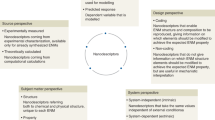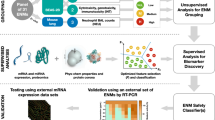Abstract
It is expected that the number and variety of engineered nanoparticles will increase rapidly over the next few years1, and there is a need for new methods to quickly test the potential toxicity of these materials2. Because experimental evaluation of the safety of chemicals is expensive and time-consuming, computational methods have been found to be efficient alternatives for predicting the potential toxicity and environmental impact of new nanomaterials before mass production. Here, we show that the quantitative structure–activity relationship (QSAR) method commonly used to predict the physicochemical properties of chemical compounds can be applied to predict the toxicity of various metal oxides. Based on experimental testing, we have developed a model to describe the cytotoxicity of 17 different types of metal oxide nanoparticles to bacteria Escherichia coli. The model reliably predicts the toxicity of all considered compounds, and the methodology is expected to provide guidance for the future design of safe nanomaterials.
This is a preview of subscription content, access via your institution
Access options
Subscribe to this journal
Receive 12 print issues and online access
$259.00 per year
only $21.58 per issue
Buy this article
- Purchase on Springer Link
- Instant access to full article PDF
Prices may be subject to local taxes which are calculated during checkout

Similar content being viewed by others
References
USEPA. Economic Analysis of the Proposed Change in Data Requirements Rule for Conventional Pesticides. (US Environmental Protection Agency, 2004).
Puzyn, T., Leszczynska, D. & Leszczynski, J. Toward the development of ‘Nano-QSARs’: advances and challenges. Small 5, 2494–2509 (2009).
Dreher, K. L. Health and environmental impact of nanotechnology: toxicological assessment of manufactured nanoparticles. Toxicol. Sci. 77, 3–5 (2004).
Toropov, A. A., Leszczynska, D. & Leszczynski, J. Predicting water solubility and octanol water partition coefficient for carbon nanotubes based on the chiral vector. Comput. Biol. Chem. 31, 127–128 (2007).
Toropov, A. A. & Leszczynski, J. A new approach to the characterization of nanomaterials: predicting Young's modulus by correlation weighting of nanomaterials codes. Chem. Phys. Lett. 433, 125–129 (2007).
Hu, X., Cook, S., Wang, P. & Hwang, H. M. In vitro evaluation of cytotoxicity of engineered metal oxide nanoparticles. Sci. Total Environ. 407, 3070–3072 (2009).
Neal, A. L. What can be inferred from bacterium–nanoparticle interactions about the potential consequences of environmental exposure to nanoparticles? Ecotoxicology 17, 362–371 (2008).
Puzyn, T., Mostrag, A., Falandysz, J., Kholod, Y. & Leszczynski, J. Predicting water solubility of congeners: chloronaphthalenes—a case study. J. Hazard. Mater. 170, 1014–1022 (2009).
Heinlaan, M., Ivask, A., Bilnova, I., Dubourguier, H. C. & Kahru, A. Toxicity of nanosized and bulk ZnO, CuO and TiO2 to bacteria Vibrio fischeri and crustaceans Daphnia magna and Thamnocephalus platyurus. Chemosphere 71, 1308–1316 (2008).
Adams, L. K., Lyon, D. Y. & Alvarez, P. J. Comparative eco-toxicity of nanoscale TiO2, SiO2, and ZnO water suspensions. Water Res. 40, 3527–3532 (2006).
Stewart, J. J. P. Optimization of parameters for semiempirical methods. V: modification of NDDO approximations and application to 70 elements. J. Mol. Model. 13, 1173–1213 (2007).
Linkov, I. et al. Emerging methods and tools for environmental risk assessment, decision-making, and policy for nanomaterials: summary of NATO Advanced Research Workshop. J. Nanopart. Res. 11, 513–527 (2009).
Auffan, M., Rose, J., Wiesner, M. R. & Bottero, J. Y. Chemical stability of metallic nanoparticles: a parameter controlling their potential cellular toxicity in vitro. Environ. Pollut. 157, 1127–1133 (2009).
Kim, J. S. et al. Antimicrobial effects of silver nanoparticles. Nanomed. Nanotechnol. Biol. Med. 3, 95–101 (2007).
Pal, S., Tak, Y. K. & Song, J. M. Does the antibacterial activity of silver nanoparticles depend on the shape of the nanoparticle? A study of the gram-negative bacterium Escherichia coli. Appl. Environ. Microbiol. 73, 1712–1720 (2007).
Auffan, M. et al. Relation between the redox state of iron-based nanoparticles and their cytotoxicity toward Escherichia coli. Environ. Sci. Technol. 42, 6730–6735 (2008).
Burello E. & Worth, A. P. A theoretical framework for predicting the oxidative stress potential of oxide nanoparticles. Nanotoxicology doi:10.3109/17435390.2010.502980 (15 July 2010).
Daoud, W. A., Xin, J. H. & Zhang, Y. H. Surface functionalization of combined bactericidal activities. Surf. Sci. 599, 69–75 (2005).
Cronin, M. T. D. & Schultz, T. W. Pitfalls in QSAR. J. Mol. Struct. 622, 39–51 (2003).
Eriksson, L. et al. Methods for reliability and uncertainty assessment and for applicability evaluations of classification- and regression-based QSARs. Environ. Health Perspect. 111, 1361–1375 (2003).
Kubinyi, H. Methods and Principles in Medicinal Chemistry Vol. 1 (eds Mannhold, R., Kroogsgard-Larsen, P. & Timmerman, H.) (VCH, 1993).
Stewart, J. J. P. MOPAC2009 (Stewart Computational Chemistry, 2009).
Jensen, F. Introduction to Computational Chemistry (Wiley, 1999).
Puzyn, T., Suzuki, N., Haranczyk, M. & Rak, J. Calculation of quantum-mechanical descriptors for QSPR at the DFT level: is it necessary? J. Chem. Inf. Model. 48, 1174–1180 (2008).
PLS_Toolbox, ver. 4.2.1 (Eigenvector Research, 2007).
MATLAB_7.6, available at http://www.mathworks.com (MathWorks, 2008).
Acknowledgements
The authors acknowledge support from the National Science Foundation (NSF) Interdisciplinary Nanotoxicity Center (grant no. HRD-0833178) and the NSF Experimental Program to Stimulate Competitive Research (award no. 362492-190200-01\NSFEPS-0903787), the Department of Defense through the US Army Engineer Research and Development Center for three generous contracts (High Performance Computational Design of Novel Materials (HPCDNM), contract no. W912HZ-06-C-0057; Chemical Material Computational Modeling (CMCM), contract no. W912HZ-07-C-0073; Development of Predictive Techniques for Modeling Properties of NanoMaterials Using New Quantitative Structure–Property Relationships/Quantitative Structure–Activity Relationships Approach Based on Optimal NanoDescriptors, contract no. W912HZ-06-C-0061). T.P. thanks the Foundation for Polish Science for a fellowship and research grant under the ‘FOCUS 2010’ Program supported by the Norwegian Financial Mechanism and the European Economic Area Financial Mechanism in Poland. This work was supported by the Polish Ministry of Science and Higher Education (grant no. DS/8430-4-0171-0). A.T. expresses gratitude to the Marie Curie fellowship for financial support (contract no. 39036).
Author information
Authors and Affiliations
Contributions
X.H., T.P.D. and H-M.H. carried out empirical testing of the cytotoxicity of the metal oxides to E. coli. A.M. designed molecular clusters for calculations. T.P., B.R., A.G., A.M., A.T., D.L. and J.L. performed quantum-mechanical calculations, selected the optimal structural descriptors, developed and validated the nano-QSAR model and discussed the results.
Corresponding author
Ethics declarations
Competing interests
The authors declare no competing financial interests.
Supplementary information
Supplementary information
Supplementary information (PDF 646 kb)
Rights and permissions
About this article
Cite this article
Puzyn, T., Rasulev, B., Gajewicz, A. et al. Using nano-QSAR to predict the cytotoxicity of metal oxide nanoparticles. Nature Nanotech 6, 175–178 (2011). https://doi.org/10.1038/nnano.2011.10
Received:
Accepted:
Published:
Issue Date:
DOI: https://doi.org/10.1038/nnano.2011.10
This article is cited by
-
Phyto-mediated synthesis of CuO nanoparticles using aqueous leaf extract of Artemisia deserti and their anticancer effects on A2780-CP cisplatin-resistant ovarian cancer cells
Biomass Conversion and Biorefinery (2024)
-
Machine learning-based models to predict aquatic ecological risk for engineered nanoparticles: using hazard concentration for 5% of species as an endpoint
Environmental Science and Pollution Research (2024)
-
A Nano-QSTR model to predict nano-cytotoxicity: an approach using human lung cells data
Particle and Fibre Toxicology (2023)
-
A review on potential approach for in silico toxicity analysis of respirable fraction of ambient particulate matter
Environmental Monitoring and Assessment (2023)
-
Factors affecting the toxicity and oxidative stress of layered double hydroxide-based nanomaterials in freshwater algae
Environmental Science and Pollution Research (2023)



